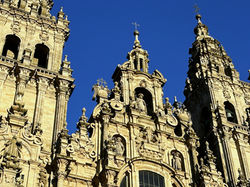
Spain | Santiago de Compostela
 |
|---|
The Convent of San Francisco de Valdedios was founded by St. Francis of Assisi during his visit to Santiago de Compostela in 1214. The land was purchased from the monks of San Marino for the symbolic annual rent of a basket of trout. St. Francis commissioned a coalman called Cotolay to build the convent. He was able to do this thanks to the miraculous discovery of a treasure.The present day baroque church was built between 1742 and 1749, reflecting great simplicity and formal purity. Later on, a neoclassical alteration modified the facade, which includes an image of St. Francis by the sculptor Ferreiro .
 The monument to St. Francis, conceived as a a giant stone cross, is on of Asorei's best sculptures. |
|---|
 The facade of the Church of San Francisco |
|---|
 The Main Altar at St Francis |
|---|
 Statue of St Francis |
|---|
 The Cathedral of Santiago de Compostela |
|---|
Due to our limited time in Santiago de Compostela we were not able to see the interior of this cathedral. This will definitely be a priority on another visit as it appears to be incredible. The outside of the Cathedral itself is massive and was built in many different styles over centuries. It is the reputed burial site of St. James the Great, one of the twelve apostles. According to the legend, St. James the Great brought Christianity to the Iberian peninsula. The tomb was rediscovered in 814 AD when strange lights in the night sky over Libredon forest were witnessed. Bishop Theodomirus of Iria recognized this as a miracle and informed King Alfonso ll. The king ordered the construction of a chapel on the site. Legend has it that the king ws the first pilgrim to this shrine. This was later followed by the building of a church and the gradual developement of this major place of pilgrimage.
 Detail on the Outside of the Cathedral |
|---|
 The Pazo de Roxoi or Raxoi Manor is located in the Plaza del Obradoiro, right in front of the cathedral, and is currently the headquarters of the Santiago City Council and the regional government. Originally the building was used as a prison and town hall as well as housing the cathedral choir boys, acolytes and priests. |
|---|
 Walking in the Square |
|---|
 It was wonderful to walk the streets here in the evening. We were able to listen to a man with a beautiful voice singing in the streets to passerbys. |
|---|
 Another view of the Cathedral |
|---|
The name Gibraltar originates from Arabic and means "Mountain of Tarique". The mountain is a militarily strategic promontory at the entrance to the Mediterranean Sea and guards the oceanic strait that separates Africa from the European continent. It was formerly called by the Phoenicians Calpe, one of the pillars of Hercules.The Gibraltar region has its first signs of human occupation dated between 128 and 38 thousand years before Christ, including the presence of extinct Neanderthals. Gibraltar is one of the British overseas territories.
 The Casa del Cabildo or House of the star was built in the 18th century. The building was born as an urban response from the Cathedral chapter to form the space of the Plaza de Praterious. It is considered one of the most important and well-known intereventions of Galician baroque scenography. |
|---|
 More of the Cathedral |
|---|
 The Cathedral is Immense! |
|---|